If there’s a group of birds on the face of the earth that is almost universally loved it seems to me that it would have to be owls.
Many folks are captivated by them for their large forward-facing eyes, quizzical expressions, eerie vocalizations and the sense of mystery provided by their generally nocturnal habits. Others appreciate their many unique adaptations, such as silent flight and their ability to turn their heads 270 degrees. There’s just something about owls…
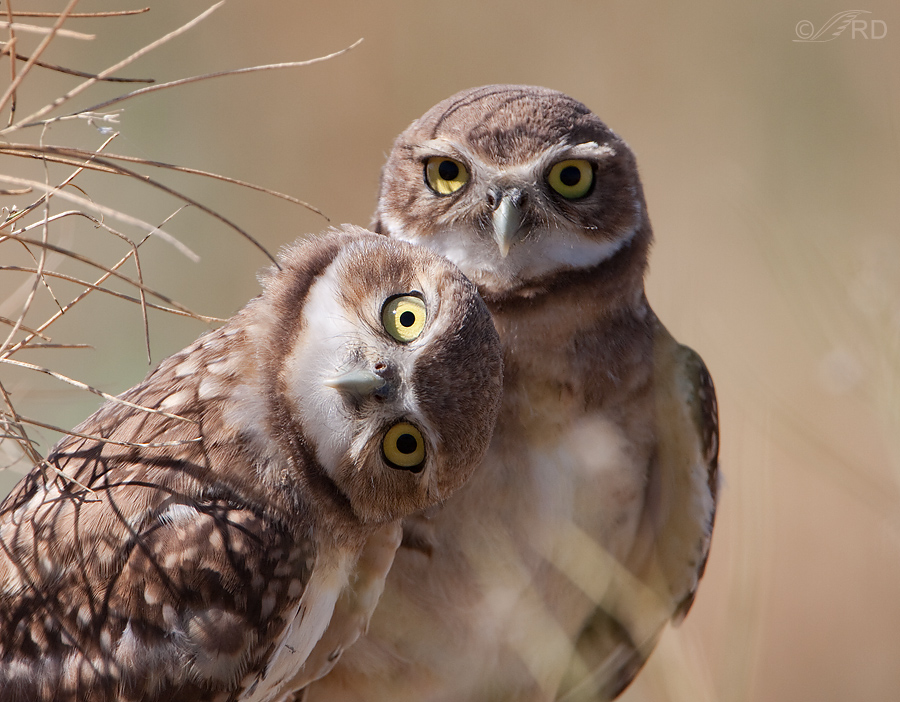
1/640, f/9, ISO 400, 500 f/4, 1.4 tc
And for many of us Burrowing Owls are at the pinnacle of that adoration. Their comical antics, especially those of the juveniles, tug at our heartstrings and make us smile. And they’re more accessible to viewing than are most owls because they’re active during daylight and spend much of their time on the ground close to their burrows instead of being hidden high up in trees. The flip-side to all this is that Burrowing Owls are extremely vulnerable to unthinking human intrusion – especially while they’re nesting and caring for chicks or juveniles.

1/4000, f/6.3, ISO 500, 500 f/4, 1.4 tc
In Utah the burrows of these owls are typically found among sagebrush, which they often use as perches during early morning. This allows the patient and ethical birder or photographer a good look at the birds without having to get too close in order to see through the vegetation usually found in the burrow area.
It’s not unusual for Burrowing Owls to nest close to roads and when they do they become accustomed to traffic. If you stay in your vehicle and are patient with them they will go about their normal, natural business without being unduly disturbed. But one must be mindful of any sign of nervousness, especially during nesting season. If the owls begin to bob their heads and “chatter” you are too close. These owls will abandon burrows and nests with too much human disturbance and their burrows may collapse from foot traffic so the burrows should never be approached closely. The populations of Burrowing Owls in North America have declined sharply in recent years from the cumulative effects of human activity and they have been listed as a “Species of Special Concern” by the US Fish and Wildlife Service in several western states, including Utah. They need our help and deserve our respect.
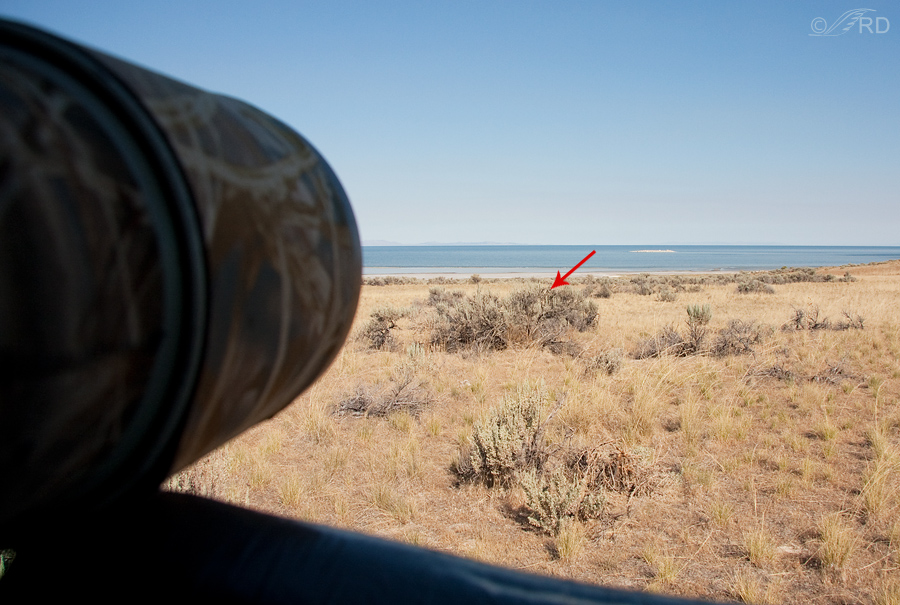
When I photograph Burrowing Owls on Antelope Island I always shoot from my pickup from the edge of the road. When their burrow is close to a road they usually become accustomed to vehicles but as soon as you exit your car their behavior immediately changes and they generally fly off so I never even open the door. However, when they’re caring for chicks or juveniles they’re more reluctant to leave the area so they will typically fly a very short distance and show signs of alarm and stress.
I’ve included the photo above to show you a typical scenario when I’m photographing Burrowing Owls from my pickup. The red arrow marks the owl.
Now to the heart of the matter. When I first started photographing birds there were Burrowing Owls near some rock piles southeast of the visitor center on Antelope Island and that burrow was active for several years. Then one spring about five years ago they abandoned the burrow. I asked one of the employees at the visitors center what happened and he told me that the owls had been “loved to death” by human visitors to the island.
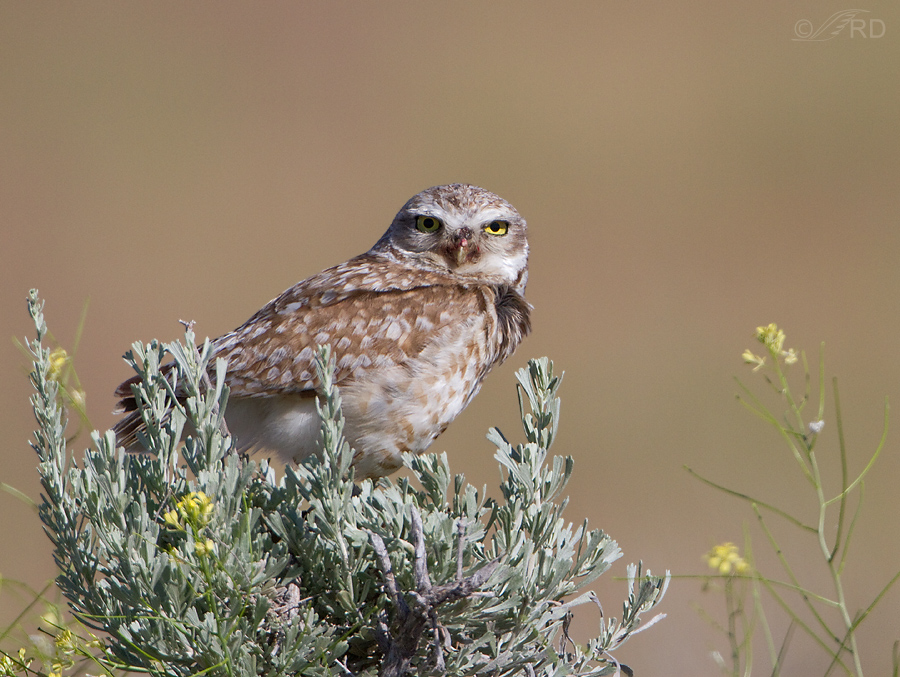
1/3200, f/6.3, ISO 500, 500 f/4, 1.4 tc
Then we found another active burrow close to the road and photographed those birds for several years. As is typical they were accustomed to the traffic and not disturbed if folks watched and photographed them from their vehicles. Early in the spring last year an obviously mated pair of owls showed up at the burrow and set up residence. But as we drove by the burrow on the morning of March 13, 2011 both Mia and I were aghast at what we saw – a group of birders and photographers had left their cars and were walking all over the burrow area, including tramping right over top of it. We never once saw two owls at the burrow after that day. One of the birds stuck around until mid-summer and then was gone but obviously no chicks were produced that year. While this owl was still there it would chatter in alarm and hide low in the sagebrush or fly off almost every time a vehicle stopped along the road – a behavior it had never exhibited before. We got very few images of this bird after “the incident”, partly because we didn’t want to disturb it further. This was one of the last shots I got of that owl, taken on 6/22/11.
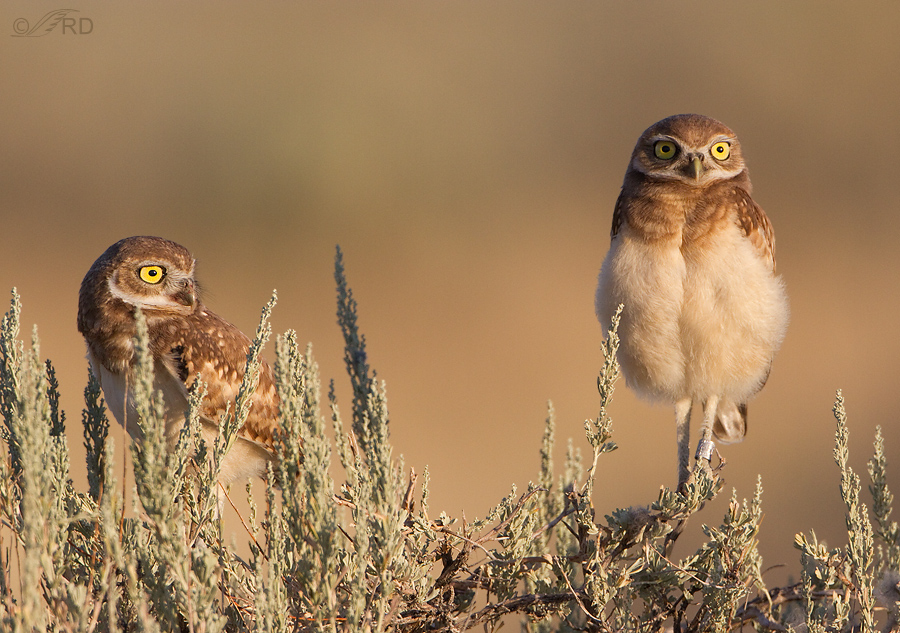
1/1600, f/7.1, ISO 640, 500 f/4, 1.4 tc
Thankfully, a pair of owls showed up at the burrow area this spring and raised a clutch of chicks. We’ve seen at least four of the fledglings and these are two of them. As you can see from their unmarked, buffy bellies these birds are still very young and they have been banded. At this age they spend much of their time on the ground hiding among the sagebrush and grasses while waiting for the parents to bring them food. It’s a bonus to catch them up on the sagebrush in good light like this.
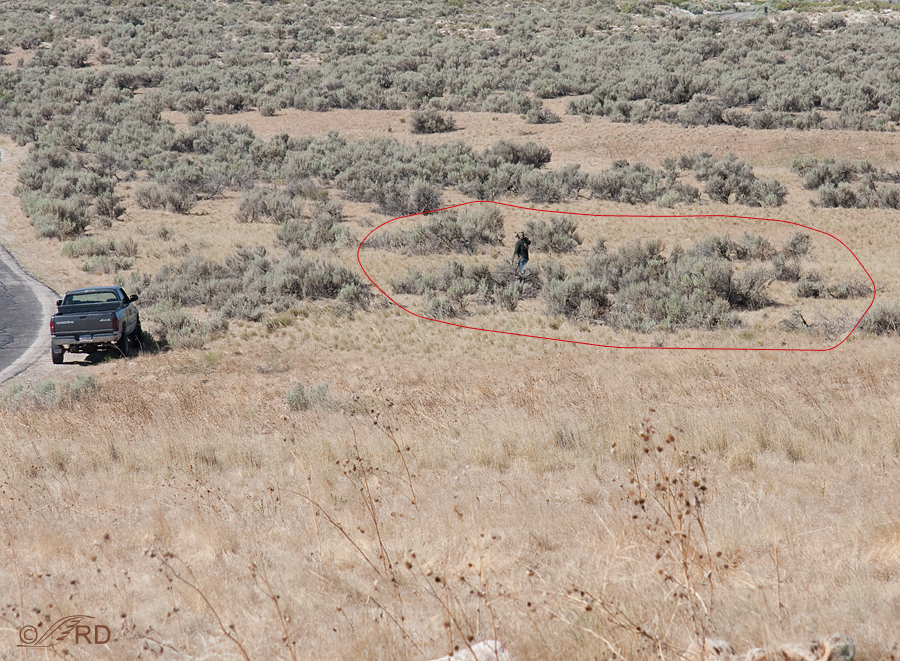
Then it happened again. Last Wednesday, 6/27/12, as we drove by the burrow area there was a photographer who had left his vehicle and was photographing the owls at extremely close range in the immediate vicinity of the burrow and all the sagebrush that these owls habitually perch on (outlined in red). As we passed by with our windows open we could hear the adult owls screeching and chattering in alarm at his intrusion. I drove further up the road, then turned around and watched what was happening through my lens. The image quality of these last four shots is poor because I was so far away from what I was photographing. In this image the photographer is walking toward the owl after it had been flushed to a new perch.
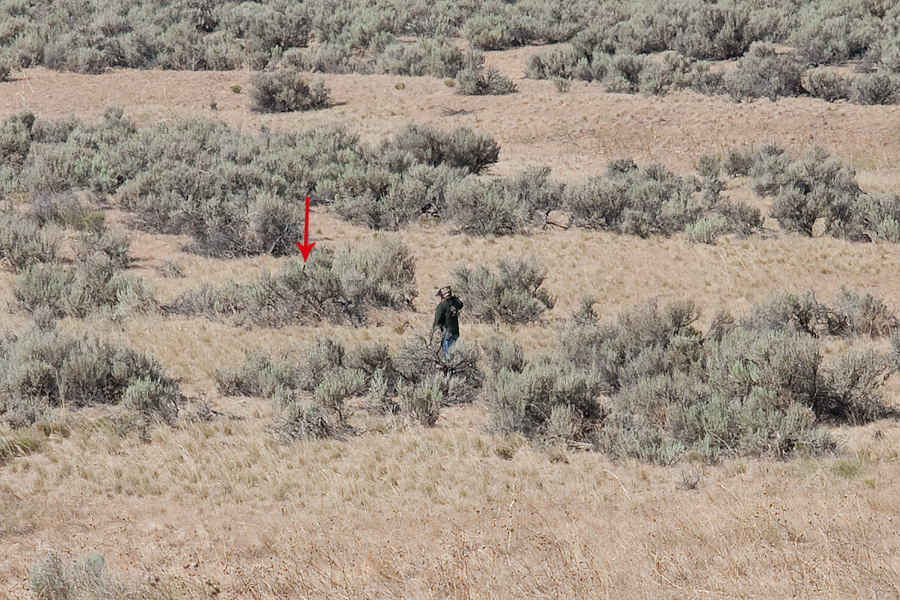
In this extreme crop of the previous image you can more clearly see the owl the photographer is approaching. At this point we were upset by what we were seeing and left the area.
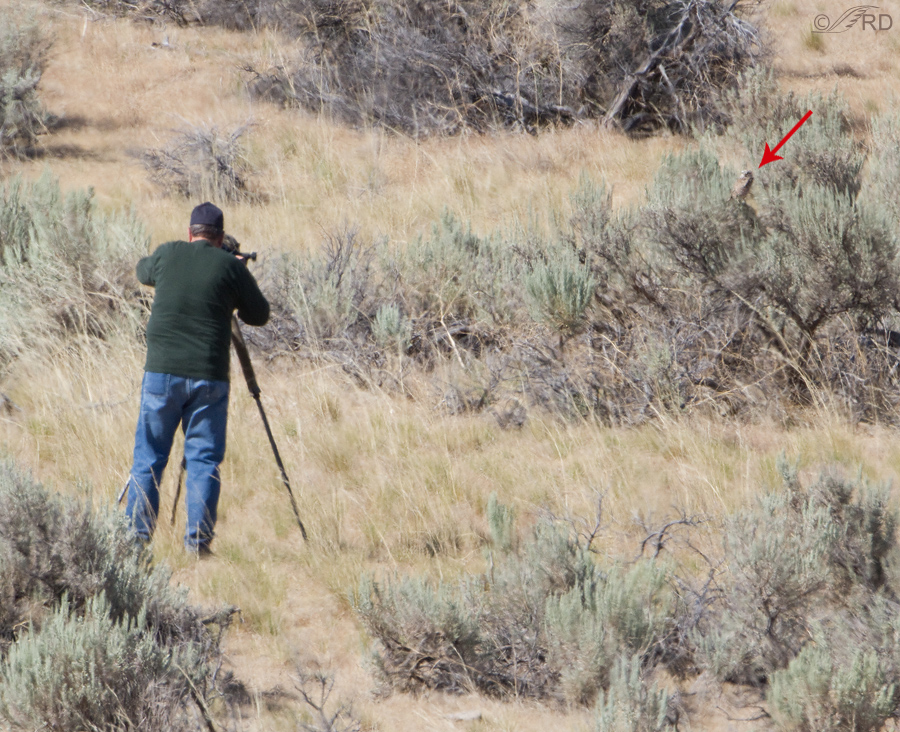
49 minutes later we returned to a slightly different vantage point and the photographer was still shooting the owls. Of course the chicks were trying to hide in the grasses and sagebrush and the adult was fairly reluctant to fly off very far with the chicks in such a vulnerable situation. The photographer had been shooting the adult on the right when he apparently saw one of the chicks on the ground and was aiming at it in this photo.
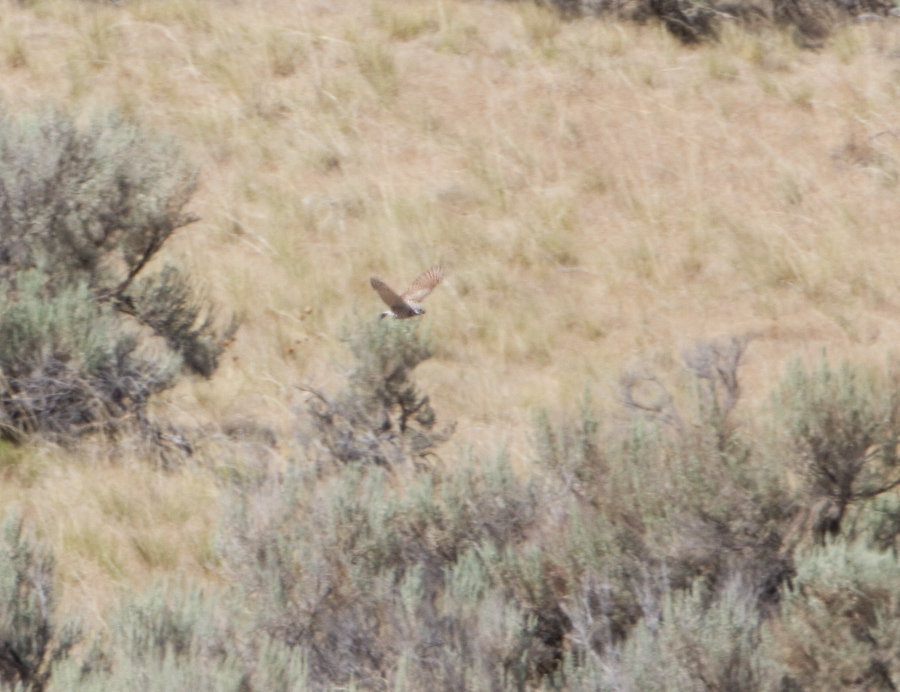
When the photographer would get too close the adult would flush and fly to another nearby sagebrush and the photographer would attempt to approach it again.
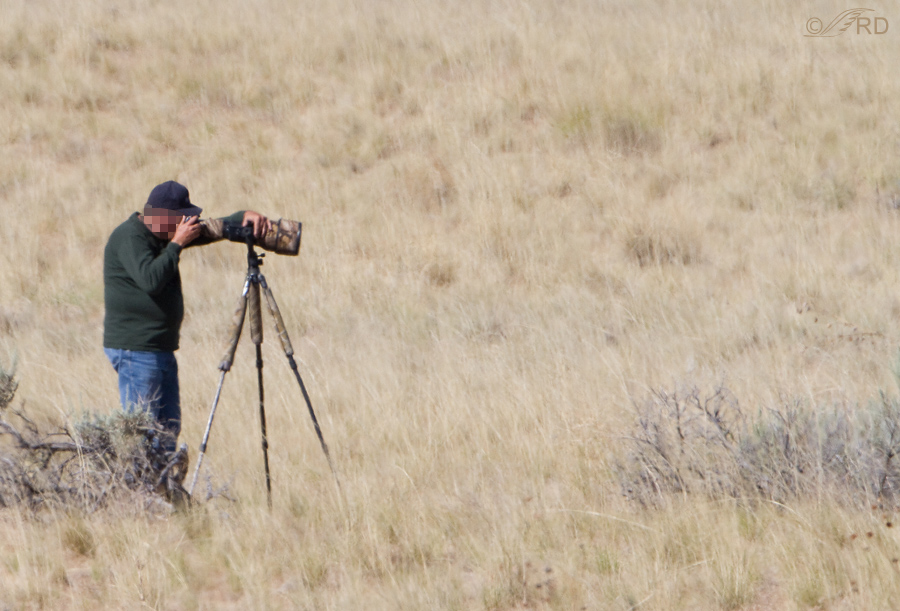
You can extrapolate just how close this photographer was to one of the owls (out of frame to the right) by noticing the angle of his lens relative to the ground.
Please, lets all of us give Burrowing Owls the space and respect they need and deserve! If birders, bird photographers and the general public don’t start policing themselves better I’m afraid restrictive regulations will be put in place to better protect these fragile birds (and others) from being “loved to death”. If we don’t do it, someone else will surely do it for us and it won’t be pretty. And if that becomes necessary, everyone loses – including the owls.
“The Shot” simply isn’t worth it.
Ron
Note: All of these images were taken recently from my vehicle at the sagebrush patch referred to in the post with the exception of the first photo, which was taken several years ago along the causeway to Antelope Island.


Your site is great and I respect your ethos…but you should have said something to the guy and maybe explain how his behavior is hurting the birds.
I know you aren’t a Ranger, etc. but you could maybe relate to him on the photog tip and then pepper in some points on outdoor manners.
God knows no one else would ever say something.
Thanks for your input MW.
“you should have said something to the guy and maybe explain how his behavior is hurting the birds”.
Well, in this case I chose not to do so and given the same situation I’d make that decision again. Photographically this guy is obviously no babe in the woods – given his gear he’s a serious bird photographer and he knew exactly what he was doing. It’s most likely that nothing I could have said would have been new to him.
Two weeks ago I did “say something” to two photographers at the very same location, but that was a very different situation. They had exited their cars to photograph the owls (from the road edge) with relatively short lenses and I was fearful that they would walk toward the burrow and harrass the owls so I told them that if they stayed in their vehicles they’re more likely to not scare off the birds and warned them of the dangers to the owls if they approached them. But these folks were most likely novice bird photographers who didn’t understand the potential implications of exiting their vehicles and approaching the owls. They were accepting of what I said, polite and soon got back in their car.
I’m pretty sure the reaction of the photographer in this post would have been much different. So, given the situation, I’m satisfied with my decision to not confront this photographer.
Ron,
Thanks for getting back to me! I hear you, and believe me you have to pick and choose your battles. Yes, this guy is geared up enough to know he is crossing the line and wouldn’t be to receptive to your concerns I am sure.
I currently live right below Griffith Park in Los Angeles, the nations largest urban park, and I find myself constantly running into “situations” where people are disrespecting nature. I too, pick and choose who I confront. I take a personal sense of stewardship for the wildlife in Griffith like you do on the Island.
Why am I bugging you and questioning a grown mans actions I don’t even know? Because I want people – anyone reading this – to feel empowered enough to say something, do something, report something if they come across unethical behavior. With the economy how it is and less oversight (this is a HUGE problem in California) by rangers, etc. it is up to citizens to protect our natural resources.
Ps….thanks for producing this site and putting out content. It serves thousands of people I am sure and your in depth look into each species and their behavior is a breath of “birder/photo blog” fresh air.
I couldn’t agree with you more MW. The staff of our state parks has been decimated and the bloodletting isn’t over yet. Some of us have to take up some of the slack I’m afraid, distasteful as it is.
Thanks for the well written and illustrated plea for ethical wildlife photography (and birding). The absolute rule is always if you cause wildlife to change their behavior, you are too close.
I was prompted to write a blog post about unethical behavior on the part of wildlife photographers not too long ago, as well (http://blog.bigskycountry.net/index.php/2012/05/30/unethical-wildlife-photographers/). In the case of my post, the photographers in question were fairly prominent — one of them being an author of many books (including bird field guides). Like you, I was upset by what I was seeing and left the area, but not before documenting the behavior I had witnessed.
Vehicles make excellent “photo blinds.” I don’t know how many times I’ve been parked photographing something and someone pulls up and opens a door and it’s all over. At that point, not only has my opportunity fled, but the animal, that was previously undisturbed, is now definitely disturbed. My most recent experience with that was a nursery elk herd along Hwy 93 north of Victor, MT on Sunday evening. In that case, the behavior on the part of others was excusable – they were tourists thrilled to see elk alongside the highway and hopped out with point and shoot cameras. I visited with them. They were disappointed that the elk fled as soon as they got out of their car. I told them I’d been parked there for five minutes and the elk kept their heads down in the grass until they got out, at which point they hastily crossed the Bitterroot River and took cover in trees. I explained that next time they’ll enjoy a longer viewing and more photos if they stay in their car.
In the case of the photographer in your illustration and the photographers in my blog post, they certainly knew what they were doing was not right and chose to do so anyway.
Thanks so much Katie and I agree with you explicitly.
I like the trend I’m beginning to see, that of ethical nature photographers (and others) beginning to sound off about the illegal and/or unethical practices of rogue photographers, birders or any other group or individual that is willing to put their own selfish goals ahead of everything and everyone else. I like to see their feet held to the fire and the more we do it the more positive results we’re likely to have.
I would encourage all of my readers to follow Katie’s link, above – a perfect example of the types of things many of us deplore but witness regularly. I applaud you for making that post Katie. It couldn’t have been easy – I know that from experience.
This event is why no one reports locations of owl sightings in Idaho. I wouldn’t tell anyone, would you?
Keep up the good work Ron and Mia. Antelope Island is a gem. A short drive from a million people. gee that is scary thought.
Rohn – No, I wouldn’t tell anyone except for perhaps a select few and you would be on that very short list. In this case though, the AI Burrowing Owls are already well known to many.
Yeesh, what to say about this kind of poor behavior… He’s not a naive scenic snapper from the looks of his photo rig, so I’ve got to assume he knows what’s what and therefore puts more value in the picture than in the subject. Completely misplaced values IMHO.
Btw- I don’t keep up on all the avian research across the state, but a band indicates someone has an interest in these particular owls. Had no idea there was a local study involving BOs. Hopefully it’s well designed and capable of shedding light on this ultra-cool specie’s decline.
Thanks Mike. I’ve been planning on asking around to see who’s doing the study.
What nincompoops! People do not use common sense. And the dry conditions should give everyone pause as that just adds more stress to wildlife. Why spend all that money on a tele lens and then disturb the wildlife anyway? And the same people wonder why the numbers of wildlife are dropping.
“Nincompoops” – love that word and you’ve used it so appropriately here Tana.
I agree with Mia, Ron. This is a great post. Personally, I never leave the vehicle unless it is absolutely necessary. We have a similar problem with the prairie dog village at the state park here. I have driven by many times and have seen people with their cameras, and their children, walking among the mounds. That is probably why it is a rarity to see any Burrowing Owl there at all. By the way, that first picture is a real keeper. Awesome pose.
Bob, I think most photographers are pretty good about not disturbing the birds but there’s a few that cause a lot of problems. And thanks, I like that first shot too.
I’m so glad you posted this Ron and I hope that people do learn to give the space and respect to nesting birds and chicks that they deserve.
Thanks Mia. We can only hope…